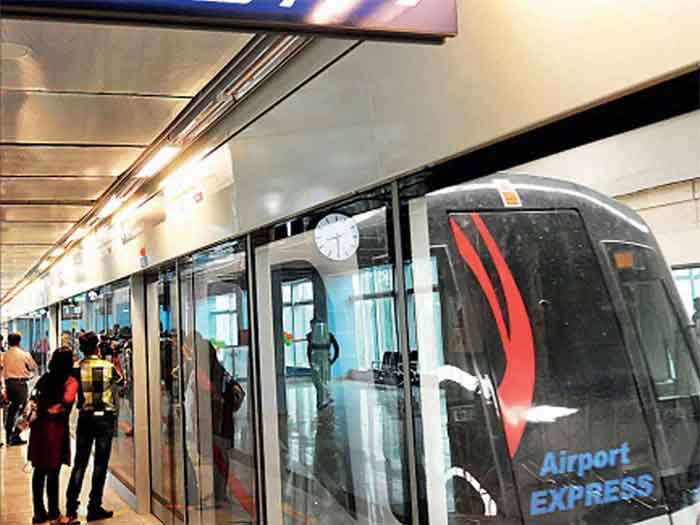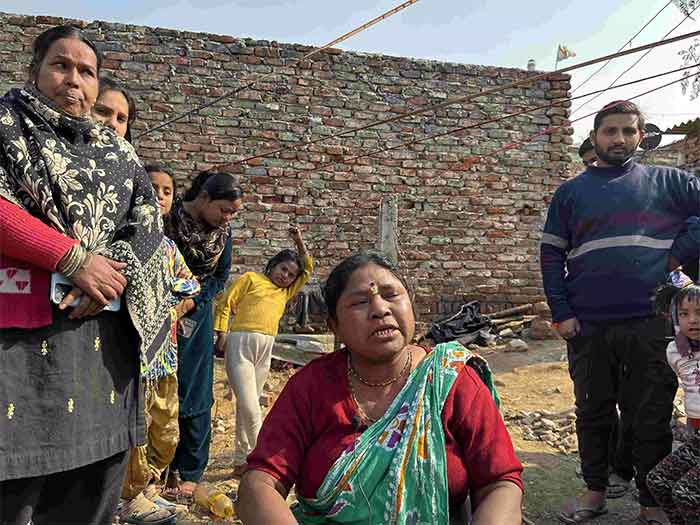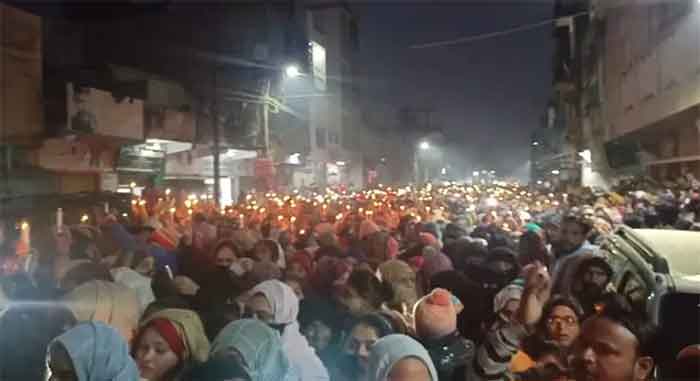
Bharat Raul’s family lived a happy life in a nice single storey settlement , Wadi, amidst coconut trees in a prime area in Mahim in Mumbai in the 1960s. Then the municipal corporation displaced it along with others for civic works and relocated them to five storey buidings near Mahim east station. . This is fine area with trees, wide roads, footpaths and open spaces. But they face dislocation again for the Dharavi slum redevelopment project to be undertaken by the controversial Gautam Adani.
There are thousands of such people who face eviction without being given any advance information, without meetings with elected representatives. They are not even in a slum, they are living in officially built colonies but have been suddenly brought within the purview of the Dharavi project. The lot of slum dwellers is much worse. This is considered a major human rights violation.
Raul lives in Shahu Nagar,the municipal colony with 47 buildings and and 1047 self contained tenements with areas ranging from 300 to 400 sq foot. The name for the colony was given by residents in memory of Chhatrapati Shahu, the social reformer and former princely ruler. Almost opposite Raul’s building is a very big public playground and behind is a nice garden named after freedom figher Prakash Samant.
It is a vibrant garden. During a visit to the area on December 4 I noticed Muslim women in burqa enjoying themselves sitting on well designed jhoolas, swings, one woman did exercise on a gym equipment. There is a fine gazebo, a sheltered space with a wooden benches.
People will lose all these amenities in the redevelopment area where they will be confined to high rise buildings with little public space because most of the space will be used for luxury housing for the wealthy. The Dharavi slum stands on prime urban land. Real estate sharks have been eyeing it for some time. Its proximity to the Bandra Kurla corporate complex BKC is a major attraction too.
A resident said we do not mind if the project is allotted to the Tatas or Godrej, but with Adani, the whole equation changes.
The Shahu Nagar municipal colony was greatly improved with shram daan by residens. It was a marshy land, there were no street lights in the beginning, we reclaimed the land. There was no bridge to the adjoining Mahim railway station, several people were injured, killed while crossing the tracks. The railways were then forced to construct a bridge. The buildings are still in a good, safe condition as the report this month of the structural audit showed. Thee is no case whatsoever for demolition and displacement.
It appears that in the zeal to clear land for the Dharavi project, the authorities may be creating a fire hazard. The staff quarters of the fire brigade in Shahu Nagar were demolished recently as also the quarters for the police and nursing staff.
I took a long walk in Dharavi on December 4. From Sion station to Mahim. Dharavi is maligned as a dirty slum but I noticed there are large areas which are perfectly in good shape. There was a very big vegetable market all along a narrow road covered with plastic shed and its vibrancy would be the envy of Westerners who now greatly prize public markets on the street. The street was crowded with women, many of them in burqas buying fresh vegetables. The area was full of life and without filth.
True, Dharavi is a big slum. But there are pockets with middle class housing. at least one coop society has taken loan from the state finance corporation. it is named after Dr A.V Baliga, a major figure in building Indo Soviet relations in the fifties and sixties. He got 3.5 acres of land officially allotted by the BMC for the housing society. it now has car parking faciliies. planned houses, lot of open space with high fsi potential. This in one of the most congested parts of the city with high population density. This society too faces demolition.
There are large pockets of insanitation but this is more due to civic neglect. Dharavi has been deliberately, according to some, been given a bad name as a dirty area, so that it can be redeveloped for profits for some.
I myself walked sometime ago in Shahu Nagar, a walkable distance from a pedestrian bridge on the eastern side of Mahim station. It is like a well planned housing board colony . There was no filth anywhere.
With Mr Adani’s firm being selected for the redevelopment, the issue has acquired a new dimension. The main fear is of loss of livelihoods, loss of jobs,schools which are free or have low fees, and dispensaries , eateries and gardens accessible now ..
Many living here for generations do not have legal documents which makes them very vulnerable. It is very difficult to get documents. A big industry has grown here where dalals collect big sums to arrange documents.
Experts are sceptical about the project for the right reasons but women in particular do want redeveloment as they can be assured of proper toilet facilities, so they can escape the humiliation of walking to toilets in the public eye, standing in queues.
I listened to academics, activists, social workers, Dharavi residents at a a discussion organised by Working People’s Coalition, Yuva, Halwa and Acorn at the YMCA in Bombay Central on December 3.
The picture is very complex. There are multitudes of trades, residential Nagars where people do commercial work in their homes or in areas outside.
The large recycling business here is now giving way to the garment industry which requires less space and yields more profits. Actually, the recycling work is so beneficial to the society, the area should actually get carbon credits for it, said Vidyasagar Pancholi, a post doctoral researcher. Nearly 200,000 people are estimated to be working in the garment industry here. It is feared that out of a population of about ten lakh people, almost two third may be declared ineligible for benefits of redevelopment and face eviction. There is also apprehension that a special police force will be created to act against those opposing redevelopment.
Charlie Anthony, general secretary of the Baliga Nagar cooperative housing society, said there were multiple problems in the face of redevelopment. Now there are thousands of homeless people sleeping on pavements. Then no repairs to a house are permitted.. Real estate prices, however, are very high because of the central location and this area is now being eyed greedily by builders because of its proximity to the Bandra Kurla corporate complex.
The Kolis, fishermen, the original dwellers of Mumbai, the Bhoomi putras, would feel totally uprooted and alienated in any new environment, away from the land where their generations have lived, said Aarohi Damle, a researcher. The main problem is there is no common platform for people here to discuss their problems. Thee is a serious need to bring together people from different communities with different aspirations.
The main beneficiaries of the project will be the affluent moving into luxury apartments on the land. Particularly unfortunate will be the use of some prime land of some 45 acres of railways in the adjoining areas for redevelopment for this class. The city badly needs this kind of space for numerous public amenities which is not available today.
Dharavi is self organised settlement and redevelopment can be done on these lines like in Latin America, said Aniruddha Paul , professor of Kamala Raheja college of architecture . It can be done in a low-rise, high density way.
The residents argue that they filled the marshy land with a lot of labour for the reclamation and now the rich want to access it.With recycling Dharavi is actually reducing garbage, now instead of this so called slum we will have vertical slums for the poor.
With a fresh survey of Dharavi now in the pipeline for the project, there is much uncertainty about who will be declared legal and eligible for redevelopment and who will face eviction. All these years people were huddled together in congested spaces . But they have lived in peace , crime is very low. There are so many domestic trades conducted here in the open space which cannot be done in high rise buildings with all kinds of restrictions. Multiple problems.
Vidyadhar Date is a senior journalist and author of a book on public transport















































